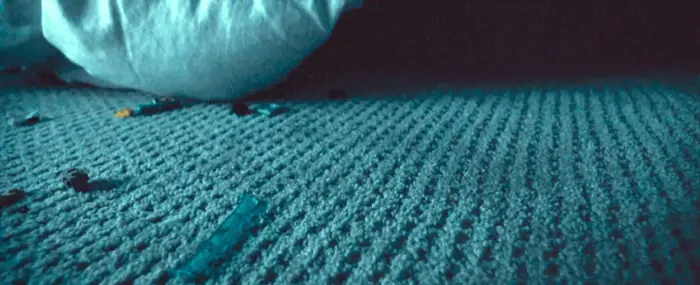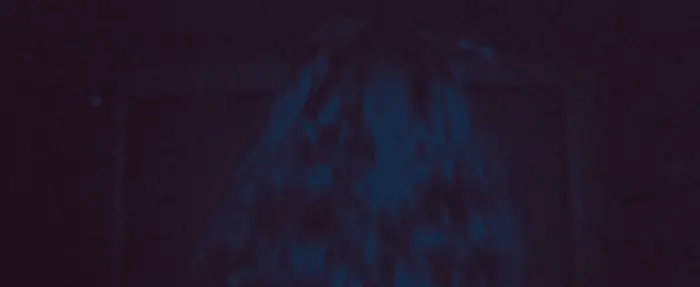A couple of things to get out of the way right off the bat: Kyle Edward Ball’s Skinamarink is both the best horror film and the scariest…anything I’ve ever seen, as well as a film that I genuinely feel will be foundational to both the analog horror subgenre and horror as a whole for years to come. Just like with the advance preview of the film on our sister site Horror Obsessive, the screener I was provided with came directly from me reaching out to Ball himself. I am beyond thankful to the director for giving me early access to his film—and in a genuine way, I feel privileged to have been able to get an early viewing of a film that’s this damn good. With all that said…let’s dive in.
The problem that comes with seeing too many horror movies (and if my output at Horror Obsessive tells me anything, it’s that I’ve seen far too many horror movies) is that it doesn’t take too long for them to stop being scary. No matter how well executed a film might be or how adequate it might be at building up tension, there’s always some…thing that takes you out of the terror, that makes you stop and go “oh yeah, this is just a movie”.
Even the best practical effects are just that: effects. They can certainly shock and disgust, but see enough of them and their ability to invoke genuine terror fades away—if it doesn’t disappear entirely. Don’t get me wrong, I still enjoy the hell out of my horror films, but nowadays the feelings they invoke are more in line with the thrills you might find at an amusement park’s rides rather than the raw, unadulterated terror felt when I first found myself being sucked into the genre.

Stephen King—who certainly knows a thing or two about how to scare someone—wrote something to this effect in his non-fiction work Danse Macabre: “Nothing is so frightening as what’s behind the closed door. The audience holds its breath along with the protagonist as she/he (more often she) approaches that door. The protagonist throws it open, and there is a ten-foot-tall bug. The audience screams, but this particular scream has an oddly relieved sound to it. ‘A bug ten feet tall is pretty horrible’, the audience thinks, ‘but I can deal with a ten-foot-tall bug. I was afraid it might be a hundred feet tall’.” No matter what the thing on the other side of the door turns out to be, it’s never as scary as the thought of what it could be.
What makes Skinamarink so singularly terrifying is that it is, in effect, roughly an hour and forty minutes of looking at said closed door. We get glimpses of what might be on the other side: the disembodied voices always communicating from somewhere else in the house or just out of view; the windows, doors, and other household objects that disappear with no rhyme or reason; the rooms that we inexplicably discover to be upside down. We even get extended sequences featuring early Fleischer/Iwerks era cartoons—curiously enough, at least two of which (Balloon Land and Bimbo’s Initiation) are ones I actually recognize from old Cracked lists on “old timey scary/messed up cartoons”—playing on an old analog TV that seem to run parallel to what’s happening just outside our field of view: a rabbit vanishing into thin air, two children find themselves lost in the woods and chased by a monster, a dog trying to escape a room only to realize that he’s trapped by an endless series of doors.

But there’s no moment of revelation, no comforting release of “oh, that’s what it was, that’s nowhere near as scary as what I thought it could be.” To call Skinamarink nightmare fuel would be a gross understatement: this is a nightmare, plain and simple, one that never lets up from its first shot to its last.
Even when Kyle Edward Ball does reach into horror’s standard bag of tricks, they are used sparingly and gone before you’ve had barely any time to process them, with plenty of empty space left between each one where you have nothing but the possibility of something much, much worse. Instead, Skinamarink’s terrors are the raw, unfiltered stuff of childhood nightmares, the ones that come from when we’re still forming our understanding of the world and linger with us throughout the rest of our lives, no matter how deeply we might try to bury them. There are no walls dripping blood or reanimated corpses or malicious spirits to be found here, just the unbearable unease of finding oneself in a place both familiar and uncanny, with no one around to help or even able to reach you, surrounded by darkness seemingly filled with any number of unknown…somethings just waiting to get you.

Any time a film on a roughly $15,000 budget gets any sort of theatrical release, odds are it’s something special, and Skinamarink is absolutely something special. As the title of this review suggests, it brings to mind (at least for me) the likes of Eraserhead and Citizen Kane, if not in style then certainly in spirit. Like either of those films, Skinamarink is the result of a first-time filmmaker doing their own damn thing their own damn way and executing their vision so well that it practically invents its own language of cinema. So much of Skinamarink—the agonizingly slow pacing, the almost complete lack of a narrative or characters, the dialogue so muted that it almost all needs subtitles, the long shots that focus on seemingly nothing, the unorthodox camera angles that evoke a child’s point of view—feels directly antithetical to what we normally think a film should be, but it’s so exquisitely put together that if anything, you’ll likely find yourself wondering why there weren’t more films like it already.
Is it for everyone? Absolutely not, a fair amount of people will almost certainly be scared off by either the subject matter or the film’s agonizingly slow pace, but those who have the patience (and the stomach) for such a film will find a film that is nothing short of a masterpiece. Kyle Edward Ball may not have invented analog horror—although he has been honing his craft since 2015 on his YouTube channel Bitesized Nightmares, long before the genre found widespread popularity through the likes of The Backrooms—but with Skinamarink, he has almost certainly both perfected the genre and defined it for years to come.
Skinamarink will be in theaters January 13th, and streaming on Shudder later in 2023.



